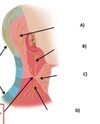Spinal and Named Nerves: Anatomy, Clinical Tests Flashcards
What are the 6 somatic general sensory symptoms a patient may complain of if they are suffering from a nervous system pathology
- Pain (neuralgia)
- Pins & Needles (paraesthesia)
- Numbness (anaesthesia)
- Sensitivity (hyperaesthesia)
- Thermal (hot or cold)
- Loss of co-ordination/balance/clusminess (e.g. ataxia)
What are the 4 somatic motor symtpoms a patient may complain of if they are suffering from a nervous system pathology?
- Muscle stiffness, tightness or spasm (cramp)
- Muscle floppiness or looseness (reduced tone or hypotonia)
- Muscular weakness (reduced power)
- Loss of co-ordination/balance/clusminess (e.g. ataxia)
Label the following
(in a clockwise direction and should be 11 answers)

- Sympathetic ganglion
- Gray and white rami communicantes
- Spinal nerve
- Anterior ramus
- Posterior ramus
- Intervertebral foramen
- Spinous process
- Posterior root
- Spinal ganglion
- Anterior root
- Vertebral body
How many pairs of spinal nerves are there?
How many pairs are in each section of the spine?
31 pairs
- 8 cervical
- 12 thoracic
- 5 lumbar
- 5 sacral
- 1 coccygeal
Do the nerves exit superiorly or inferiorly to their vertebrae?
Nerves C1-7 exit from the vertebral canal above the first 7 vertebrae
C8 exits below the 7th cervical vertebrae and the remainder leave below their corresponding vertebrae
What is different about the angle of the exit of the cervical spinal nerve roots from the vertebral canal compared to the lumbar and sacral spinal nerves?
Only in the cervical region do the spinal cord segments lie adjacent to their corresponding vertebral bodies
Below this level successive spinal nerve roots follow an increasingly oblique and long downwards course to reach their respective intervertebral foramina
What functions does the spinal nerve supply for it’s respectiev segment of the body wall?
- General somatic sensation
- General somatic motor
- Autonomic (motor)
- Spinal reflexes
Which spinal nerve has no siginificant cutaneous sensory axons?
(i.e. always motor)
C1
Which dermatome covers the clavicle and shoulder tip?
C4
The “badge patch” is associated with which dermatome?
C5
The nipple lies in which dermatome?
T4
What anatomical landmark lies in the T10 dermatome?
Umbilicus
Which areas are supplied by the C2 and C3 dermatomes?
C2: back of scalp and Adam’s apple
C3: back of neck and jugular notch
Which dermatomes supply your thumb, middle finger and baby finger?
C6: thumb
C7: middle finger
C8: little finger
Which areas are supplied byt T1 and T2 dermatomes?
T1: medial forearm
T2: medial arm and sternal angle
Which dermatome supplies the “hands in pockets” area?
L1: groin
Where do L2 and L3 supply?
L2: Anterior thigh
L3: Anterior knee
Which dermatomes supply the areas starting at the end of L3 dermatome and covering:
a) medial mallelous
b) dorsum of foot
a) L4
b) L5
Which dermatomes supply:
a) heel
b) posterior knee
c) buttocks
a) S1
b) S2
c) S3
Which dermatome covers the perineum?
S4
Which dermatome covers the perianal skin?
S5
When completing “dermatomal testing”, what are you testing?
- dorsal rootlets (sensory only)
- dorsal root (sensory only)
- spinal nerve (sensory and motor)
What’s the difference between a spinal nerve and a named nerve?
Spinal Nerve
Contains axons originating from one spinal cord level (e.g. C5 spinal nerve)
Named Nerve
Contains axons originating from one or more spinal cord levels supplying a particular area (e.g. musculocutaneous nerve- C5, 6 [7] )
A patient presents with somatic general sensory symptoms in their arm.
When you test the distribution of the symptoms what are you trying to ascertain?
If the symptoms are in a dermatomal pattern or a named nerve pattern
This gives you a clue as to where the pathology is actually occurring




